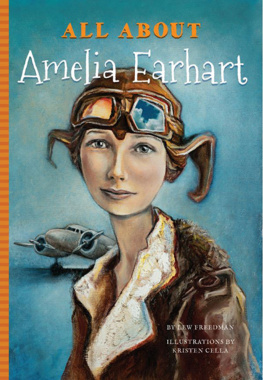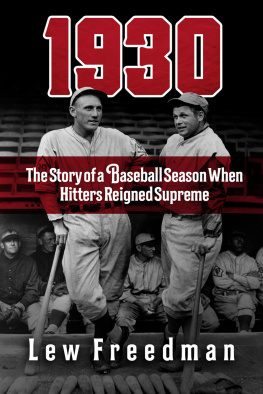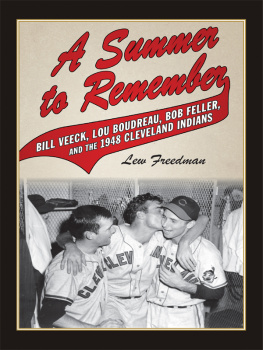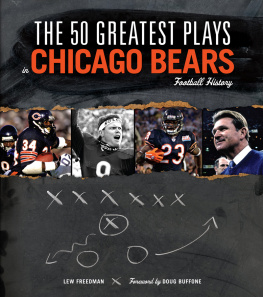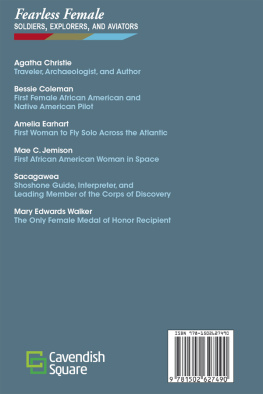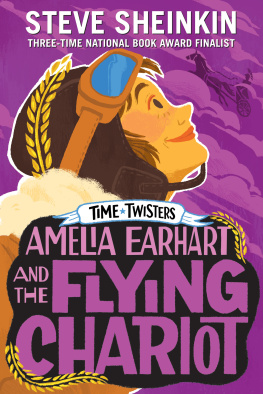All About
Amelia Earhart
Lew Freedman
BLUE RIVER PRESS

Indianapolis, Indiana
All About Amelia Earhart
Copyright 2016 by Lew Freedman
Published by Blue River Press
Indianapolis, Indiana
www.brpressbooks.com
Distributed by Cardinal Publishers Group
Tom Doherty Company, Inc.
www.cardinalpub.com
All rights reserved under International and
Pan-American Copyright Conventions.
No part of this book may be reproduced, stored in a database or other retrieval system, or transmitted in any form, by any means, including mechanical, photocopy, recording or otherwise, without the prior written permission of the publisher.
ISBN: 9781681570860
eISBN: 9781681571089
Author: Lew Freedman
Series Editor: Charleen Davis
Editor: Dani McCormick
Interior Illustrator: Kristen Cella Book
Design: Dave Reed
Cover Artist: Jennifer Mujezinovic
Cover Design: David Miles
Printed in the United States of America
Contents
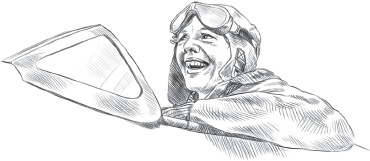
Amelia loved nothing more than flying
All About
Amelia Earhart
Preface
Amelia Earhart was a pioneer pilot, an aviator who was the best-known and most popular female flyer of her time. She established many records in the early days of flight.
She was born in Atchison, Kansas in 1897, and grew up in a time period when piloting was mostly for men. It took great skill and courage to zoom up into the unknown sky, and Amelia exhibited both of those traits. Earhart would grow into a successful woman who would capture the attention and admiration of all Americans as well as citizens around the world.
Her flying adventures in the 1920s and 1930s were very dramatic because the lightweight planes she flew were still being developed and improved upon. In fact, very few people flew anywhere to travel between cities. Instead they drove or rode the trains since they were thought to be safer. The United States, at that time, was just learning how to fly airplanes and how to enhance other ways of travel like automobiles and trains.
Pilots such as Earhart were treated as heroes as they established new records for flying. They made records for how many hours they flew in the air and how far they flew. Earhart was the first woman to fly across the Atlantic Ocean. She completed this feat alongside pilots Bill Stultz and Louis Gordon in 1928. It was very courageous of her and she received fame and honors for the accomplishment. Later, Earhart gained even greater fame around the worldand more medals and awardsfor becoming the first woman to fly solo, or alone, across the Atlantic Ocean in 1932.
During her life, Earhart accomplished things outside of aviation also. She was a generous social worker, a best-selling author, a fashion designer, a college educator, and a lifelong promoter of the rights of women and girls. She always encouraged womenwho, during her lifetime, were held back by gender traditions and lawsto find their own careers and specialties, to take charge of their own lives, and to never be discouraged by people who wished to prevent them from chasing their dreams.
In 1937, Earhart and her flight navigator disappeared during an attempted flight around-the-world. They had flown more than 22,000 miles and only had 5,000 more miles left to go. Neither Earhart nor her navigator Fred Noonan were ever seen or heard from again. It is believed their plane crashed in the Pacific Ocean near the Marshall Islands just short of their goal and close to a nearby fuel stop.
They vanished without a trace and long after Earharts and Noonans presumed death, experts still wonder what happened to them and why. Though there is no proof about what occurred on July 2, 1937 in the cockpit of the plane, periodic investigations over the decades have been undertaken. Although Amelia Earhart was only thirty-nine years old, she accomplished much and her bravery in the skies has continued to inspire many.
Chapter 1
Growing Up
Amelia Earhart grew up in Kansas. As a little girl, she was never afraid to get dirty climbing fences or playing games with her friends. Part of the time, she and her little sister Muriel, who was two years younger than she, lived with their grandparents in Atchison, Kansas, and part of the time, they lived with their parents in Kansas City, Kansas.
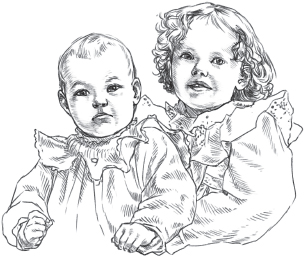
Muriel and Amelia at Muriel's first birthday party in 1900
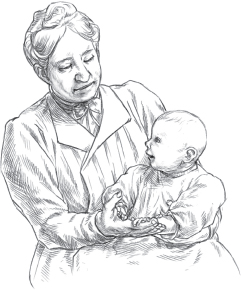
Amelia Otis, Amelia Earhart's namesake, holds her as a baby
Amelias grandmother, Amelia Otis, often scolded her for not being more ladylike. Yet Amelias father, Edwin Earhart, always encouraged her to do any activity she wanted to try, even if that meant playing games that typically boys played.
As someone who was born in 1897 and grew up during the early part of the 1900s, Amelia lived during a time when society was not as encouraging of the advancement of women compared to todays standards. Little girls were supposed to wear dresses, not pants. Little girls were supposed to learn how to take care of a house, not play sports.
From the time she was a youngster, Amelia showed signs that she was going to do whatever she wanted to do, even if others did not think that was the proper way for a lady to behave. This outlook, which Amelia maintained for her whole life, enabled her to become a pioneering aviator; to confront unusual challenges, and to always stand up for the rights of women.
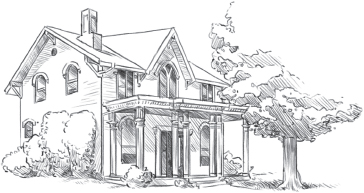
Amelia was born in her grandparents' home in Atchison, Kansas in 1897
When Amelia Mary Earhart was born, she was not born in a hospital, as became common in later years across the United States, but was born in her grandparents home.
Her grandpa, Alfred Otis, was a judge. For the first three years of Amelias life, she lived in Kansas City with her mother and her father, who was an attorney.
However, after she turned three years old, Amelia spent the winters of her youth in her grandparents home fifty miles away in Atchison. Amelia was never attracted to playing with dolls. She chose more active pursuits and adventures outdoors. As a youngster, she was exposed to fishing, bicycling, and basketball. One year she asked for a football for Christmas, which her father provided with some amusement.
Amelia was nicknamed Millie when she was a child. Three other girls her age were her closest friends and they all undertook many of these outdoor activities together. They threw mud balls at one another, frolicked on the banks of the Missouri River, and went roller skating.
Her grandparents house was surrounded by a wrought-iron fence, and when Amelia saw the boys in the neighborhood jumping over fences, she decided she could do that, instead of using the gate, as well. Her grandmother was horrified. But no matter how often Amelia was told that she was not behaving properly, she preferred going over, not around the fence.
If there was any daring adventure in the neighborhood, chances were that Amelia played a part. Once, after seeing a real roller coaster at the St. Louis Worlds Fair in 1904, Amelia enlisted friends to help her build a mini-roller coaster. And when it was complete, she insisted on taking the first ride. The model did not quite conform to any type of sophisticated model, and sure enough, when Amelia made the inaugural ride, she was flipped head over heels and tumbled to the ground. However, modifications were made, and eventually the little roller coaster worked!
Next page
